Checklist
Case 1 Nocturne for Wales (1981)
Nocturne for Wales is a collection of five stories written by Shirley Jones about her childhood in the Rhondda Valley, South Wales; they are titled “Unsound Waves,” “Bread of Heaven,” “Sheep Trials, Dog Trials,” “Bella,” and “Umbrellas.” The cover design is one of several etchings produced to accompany the stories.
Case 2 Scop Hwīlum Sang (1983)
Scop Hwīlum Sang is a suite of six etchings inspired by passages of Old English poetry. Jones’ translations appear next to the original texts. The first etching, shown here, is titled “The Wanderer.” This was the first book produced under the Red Hen Press imprint.Courtesy of the University of Vermont.
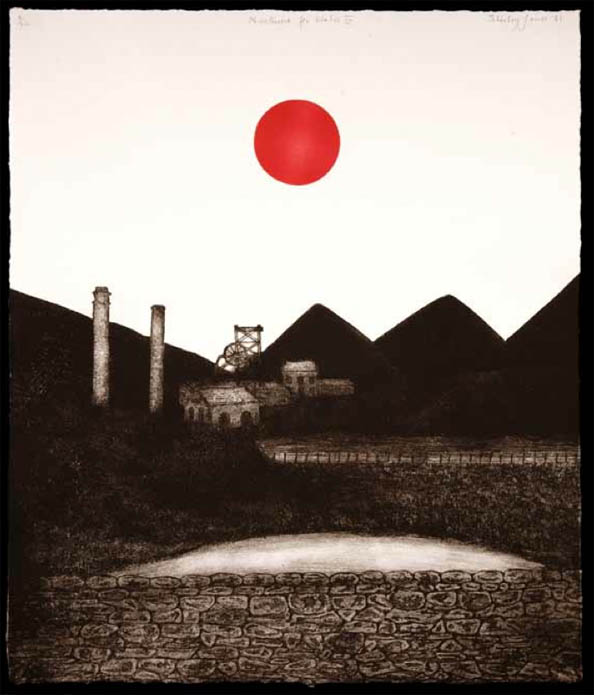
Case 3 Nocturne for Wales (1986)
The five stories in the 1981 printing of Nocturne for Wales were revised and reprinted, along with three poems, in 1986. Twenty copies of the new edition, including the one shown here, appeared with the original etchings.
Case 4 Nocturne for Wales (1986)
The 1986 printing of Nocturne for Wales was bound in rust red cloth, with the title on a rust red morocco label on the front cover. Twenty copies were housed in a large rust red cloth book-form box, with black ribbon ties, to hold the original etchings. The simple form of the title page is typical of Red Hen Press productions.
Case 5 Ellor Gāst (1986)
Ellor Gāst is Old English for “alien spirit.” This book features translations of passages from the epic poem Beowulf, along with eight aquatints. Here we see the mortally-wounded monster Grendel, following the battle with Beowulf. Courtesy of the University of Vermont.
Case 6 Soft Ground, Hard Ground (1989)
Soft Ground, Hard Ground is a book about the experiences of being a woman. It includes twelve poems and prose pieces written by Jones, as well as twelve color etchings. The etchings employ soft ground and hard ground techniques. Next to this etching is a poem called “A Kind of Sacrilege.”
Case 7 Llym Awel (1993)
Llym Awel is composed of translations of Welsh poetry dating from the seventh to the thirteenth centuries. The title means “Sharp the Wind.” There are six mezzotints and a relief etching of Welsh landscapes. The book is open to a print opposite the text “Gwen by the Llawen.”
Case 8 Y Morgrugyn Cloff (1999)
Another book dealing with Welsh literature is Y Morgrugyn Cloff, or “The Lame Ant,” which is composed of translations of The Mabinogion, the medieval collection of Welsh tales. The passages were selected “to convey the humour, irony & lyricism that permeate the stories.” The seven images employ mezzotint, aquatint, and relief etching.
Case 9 Etched in Autumn (1997)
In 1994, after having lived in London for some years, Shirley Jones returned to her native Wales. She settled near Brecon, not far from her childhood home. Etched in Autumn is “a response to the landscapes of Breconshire,” where Jones “came back to live in the autumn of her life.” Courtesy of the University of Vermont.

Case 10 Etched in Autumn (1997)
Etched in Autumn includes five folders blind-printed with etchings of local flora, fauna, and Jones’ pet cats. The folders house Japanese tissue, printed with passages from Jones’ poem “Comfort Me with Apples.” As in other books, the images employ mezzotint, aquatint, and relief etching. Courtesy of the University of Vermont.
Case 11 Etched Out (2002)
Shirley Jones has written that “Etched Out is the story, almost forgotten, of the close-knit, Welsh-speaking community evicted from their homes, so that the land on which their farms had survived for over 400 years could be turned into an army firing range.” The names of fifty farms are printed on a 5-leaf mezzotint fold.
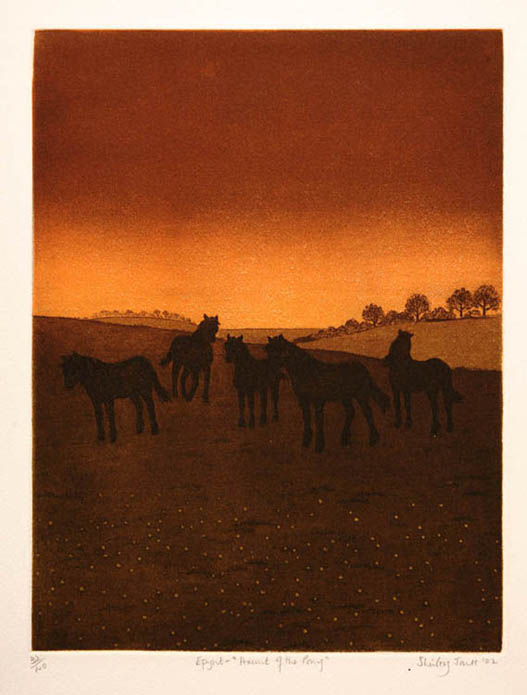
Case 12 Etched Out (2002)
“Epynt” is the name of the remote, mountainous region in Wales where this story took place. The booklet, printed in brown throughout, recounts the events that occurred in 1940. There are also six illustrations, including this one “Epynt—Haunt of the Pony.” Courtesy of the University of Vermont.
Case 13 Pick Me a Bunch of Roses (1994) and Comfort Me with Apples (2005)
Pick Me a Bunch of Roses and Comfort Me with Apples are both collections of poems, prose pieces, and translations from Old English and Old Welsh that have appeared in Shirley Jones’ artist’s books. They include reproductions of her etchings and mezzotints as well. 500 signed copies of each title were printed.
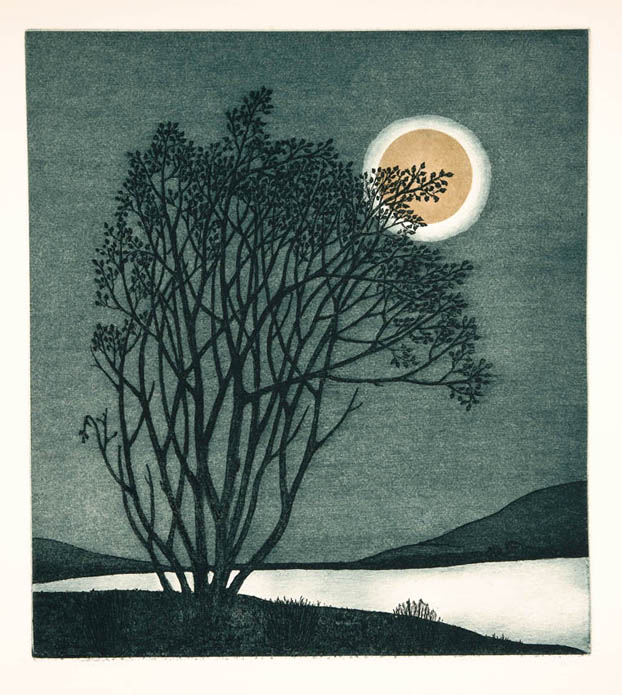
Case 14 Chwedlau ( 2005)
The colophon to Chwedlau states that the book “is an exploration by Shirley Jones into fifteen centuries of Welsh myths, legends and folklore.” Blind etchings and full-page mezzotints and aquatints accompany seven essays. This illustration depicts a harvest moon for the “tylwyth teg,” the fair folk, almost human but smaller, who lived in communities near water and held revelries at night.
Case 15 Taith Arall (2007)
Taith Arall (Welsh for “An Other Journey”) is a collection of essays dealing with Gerald of Wales’ tour in 1188 to preach for the Third Crusade. Bookbinder John Sewell produced the light blue cloth box. The prospectus gives further information about the production of the work.
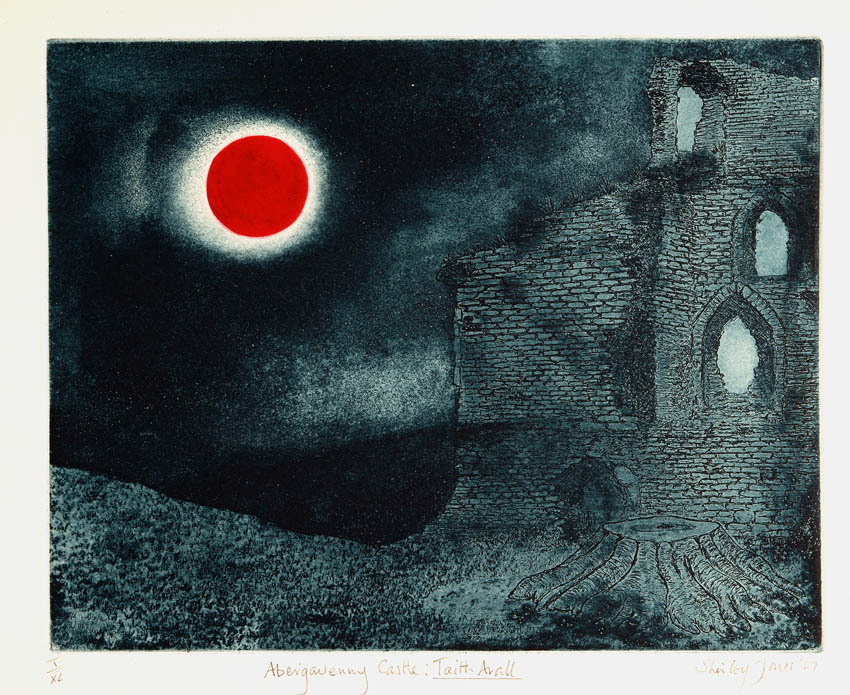
Case 16 Taith Arall (2007)
There are eight full-page aquatints in Taith Arall. This print depicts Abergavenny Castle, the site of a massacre of Welsh noblemen by the Norman Lord of the region on Christmas Day, 1175. The Welsh retaliated and left the castle in ruins. The red “sun” alludes to the carnage of that day.
Case 17 Terra Contigua (2009)
“Terra Contigua” is Latin for “Border Country.” The book is “a visual response by Shirley Jones to the poetry and prose of Henry Vaughan and Thomas Traherne,” two seventeenth century poets who lived near the Welsh border. The blind etching of “The Swan of Usk” refers to Henry Vaughan.
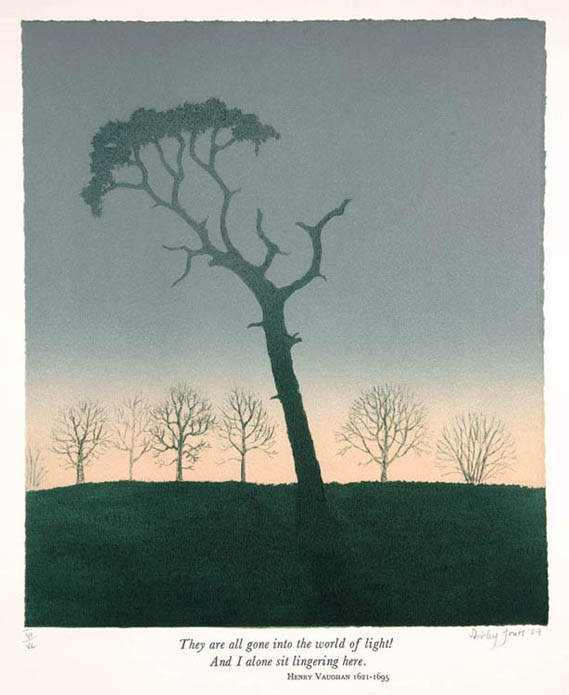
Case 18 Terra Contigua (2009)
Terra Contigua is made up of six unsewn folios, two of which enclose prints by Jones, which lay underneath excerpts from the works of Vaughan and Traherne printed on Unryushi tissue paper. The two prints shown here depict a landscape with a mandala at center (Jones’ trademark), and a Scots pine near Llangors Lake.
Case 19 A Thonnau Gwyllt y Môr (2011)
The most recent book issued by the Red Hen Press is A Thonnau Gwyllt y Môr, which means “And the Wild Waves of the Sea.” The contents deal with the coast and the islands of Wales. It includes an introductory essay, five prints, blind-printed folders, and poetic texts printed on tissue.
Case 20 A Thonnau Gwyllt y Môr (2011)
This image, an etching with aquatint, depicts the island of Grassholm, which lies off the coast of Pembrokeshire in south west Wales. In the Mabinogion, the medieval collection of Welsh tales, seven survivors of a battle in Ireland lived there for eighty years. The gannets in the image represent the survivors.